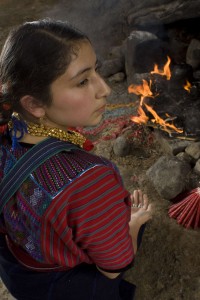 In order to keep the long-standing tradition, Ixkab’ (woman of honey) finishes the third and final cloth used to make a huipil (blouse) for her youngest daughter. Her heart is joyful, she has woven all the necessary cloths to make her husband’s, daughter’s and her own clothing. Early in the morning she will give her beloved husband all the cloths so he can begin putting them together to maintain the complement of energies. He will sit in their house, at the corridor, for 20 days with a basket full of threads to sew the huipiles, cortes (skirts), trousers and shirts, and he will have them ready before theHab’ (the New Year) so that the whole family will wear new clothes.
In order to keep the long-standing tradition, Ixkab’ (woman of honey) finishes the third and final cloth used to make a huipil (blouse) for her youngest daughter. Her heart is joyful, she has woven all the necessary cloths to make her husband’s, daughter’s and her own clothing. Early in the morning she will give her beloved husband all the cloths so he can begin putting them together to maintain the complement of energies. He will sit in their house, at the corridor, for 20 days with a basket full of threads to sew the huipiles, cortes (skirts), trousers and shirts, and he will have them ready before theHab’ (the New Year) so that the whole family will wear new clothes.
He has enough time, as it is still 25 days to the Hab’. He will sew for 20 days, until the start of the month prior to the New Year, known as the Tz’apil. The Tz’apil is a month of only five days, which are used for purification in order to begin the New Year with a clean body, spirit, heart and mind – as well as with new clothes.
Ixkab’ thought of how sad it was when those machines came to town… “What are they called?… Singer?… What is the meaning of that name? It is not a Maya name, who knows in what language it is, these machines come from elsewhere. These machines are breaking with the tradition of our people. How is it possible that men, instead of sitting in the corridor, are paying a stranger to put together their clothes in these machines?” They say the machines sew better than the hands of the men, but Ixkab’ thought her husband did a better job, for he did it with love, just as she did when she wove the cloths. “Our daughter will feel that love, the love we have for her, my husband will feel the love I have for him… How can a metal, a cold metal give love to people? Surely people were wrong, our grandmothers taught us to weave joyfully and to imprint love to the cloths, our grandfathers taught the men to sew the cloths together with strength and love…”
“We must continue this complementing, as we were taught from the time of Creation, when Tz’aqol the former of matter and B’itol the giver of breath, when Alom the female energy and K’ajolom the male energy, when Tepew, who is stability and Q’uq’kumatz who is movement, when Uk’u’x Kaj who is the heavens and Uk’u’x Ulew who is earth, when Uk’u’x Palow who is salt water and Uk’u’x Cho who is fresh water, when Grandmother Ixmukane and Grandfather Ixpiyako’k created human beings with the nine beverages of maize. They taught us the importance of this complementing in order to have balance, to find peace.” Ixkab’s thoughts continued thinking of all the energies of creation and she concluded that women alone could not do the family’s clothing, both man and woman had to work together to complement each other. It is similar to having children, she thought, a woman alone cannot have children, a man alone cannot have children; love, harmony and complementing are necessary.
This short story is a reflection of the complementing of Maya men and women, values that have been with them since the time of Creation, together with the respect they have for Mother Earth, the solidarity and community service, all of which are the pillars of Maya wisdom.
This is the first in a series of short stories written by Mayan Ajq’ij (spiritual guide) Lina Barrios from Guatemala. These stories are meant to share the knowledge and wisdom of the Mayan peoples with the world.
- Maya Cosmovision and the Modern World - January 11, 2018
- Interview w/ Lina Barrios - August 25, 2016
- Cholab’ (Ab’) New Year - February 21, 2014


You are so awesome for helping me solve this myrstey.